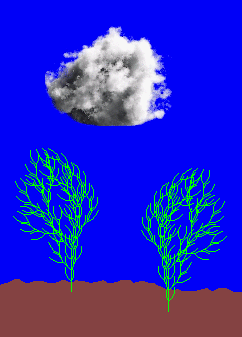Since the author Jacobo Bulaevsky died several years ago, the keyword to open any of the protected text boxes that follow is Fract (note the capital "F").
Lets start with definitions. In very simple terms, fractals are geometrical figures that are generated by starting with a very simple pattern that grows through the application of rules. In many cases, the rules to make the figure grow from one stage to the next involve taking the original figure and modifying it or adding to it. This process can be repeated recursively (the same way over and over again) an infinite number of times.
The fractals' growth mechanism can be visualized very easily with a simple example. Start with a + sign and grow it by adding a half size + in each of the four line ends. Repeat the exact same process recursively as many times as desired. We'll call this the Plusses fractal:

Notice how the + sign grows into a rhombus (popularly known as diamond) in very few simple steps. Further in the lesson we'll count the number of +'s in each of the stages to see how quickly its complexity grows.
"Mathematics, rightly viewed, possesses not only truth, but supreme beauty" -- Bertrand Russell, from The Study of Mathematics: Philosophical Essays
It is interesting to note that Bertrand Russell wrote this in 1907, which applies so well to fractals, about 70 years before they were discovered by the Polish-born French mathematician Benoit B. Mandelbrot in the 1970's 1. Mandelbrot's fractal geometry provides a mathematical model for many complex forms found in nature such as shapes of coast lines, mountains, galaxy clusters, and clouds. A very nice example of this is this picture where both the trees and the clouds are actual fractals:

Self-similarity. One interesting property that fractals can have is that of self-similarity. The name sounds complex but the idea is very simple. What self-similarity means is that each small portion, when magnified, can reproduce exactly a larger portion.
We are now ready to move on to describe a very simple mechanism on how to generate a fractal using simple mathematics.